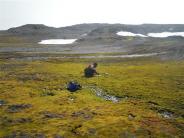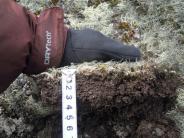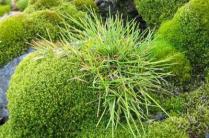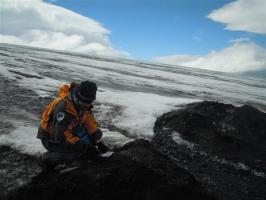Vegetación terrestre antártica - Antarctic Vegetation
Hace dos semanas se fueron Steve y Emma. Con ellos, durante todo el mes de noviembre estuvimos trabajando para obtener testigos (tubos) de sedimentos de dos lagos de península Potter (Isla 25 de Mayo-King George Island). [English translation - see below]
Los testigos sedimentarios de lagos pueden ser una herramienta útil para estudiar como cambió el clima en los últimos miles de años, como si cada capa de sedimento fuera una hoja de un libro de historia que nos cuenta qué sucedió en ese período. Seguramente ustedes nos habrán seguido en los post anteriores! Estábamos muy contentos porque nos fue muy bien y se notaba en nuestras sonrisas!
Luego de su partida, aprovechamos el tiempo y seguimos trabajando con Lucas (del grupo de Microbiología del Instituto Antártico Argentino), esta vez con sedimentos terrestres y suelos! Al contrario de los que piensan muchos, en algunos sectores de Antártida los suelos existen, más allá del clima frío y poco amigable. Generalmente se los encuentra bien desarrollados donde crece la típica vegetación antártica: musgos y dos tipos de plantas (Deschampsia antartica y Colobanthus quitensis). Con este estudio queremos saber si en estos suelos y sedimentos superficiales existen bacterias que puedan modificar la composición de los mismos, y si las hay, en qué medida lo están haciendo. También nos gustaría estimar si el aumento de la temperatura que se está registrando en la península antártica puede llegar a potenciar este fenómeno, al favorecer la actividad metabólica de estos microorganismos. Esto es muy interesante, ya que los cambios en la composición podrían impactar no sólo a los organismos terrestres, sino también a la biota marina (por ejemplo, debido a un cambio en el aporte de sedimentos de los arroyos a la caleta).
En las fotos pueden observar el verde intenso de la vegetación terrestre antártica, y cómo es el suelo debajo de ella. También pueden ver como aprovechamos el hermoso día soleado y nos aventuramos al pie del glaciar, donde tomamos sedimentos dejados por éste en su reciente retroceso.
 |
 |
 |
Steve and Emma left Jubany already two weeks ago. The month before, I had been working with them in order to get sediment cores from two lakes of Potter Peninsula (25 de mayo Island/King George Island). Lake cores can be very useful to study how the climate changed in the last thousand years. Each sediment layer of these cores would represent a sheet of a history book that tells us what happened in each moment of this period. Surely, you have been following us in the latest posts. We were very happy because we did it well as you can see on our smiles!!!
Since Steve and Emma left I have been working with Lucas (from the microbiology group of Argentinean Antarctic Institute-IAA), this time in land sediments and soils. Against the received opinion, soils in Antarctica exist, although the cold and unfriendly weather. The more developed soils can be found where Antarctic plants grow, for example mosses and two grass species (Deschampsia antartica and Colobanthus quitensis). With this study, we want to know if there are bacteria that can modify soils and sediment composition and, if they exist, what is the amount of this change. We would also assess whether the temperature rise that has been recorded in the West Antarctic Peninsula region can enhance this phenomenon, by favoring the metabolic activity of these microorganisms. The results can be very interesting, because changes in sediment composition could have impact not only on land organisms but also on marine biota (for example, due to changes in sediment supply from creeks that run into the cove).
In the pictures above you can see the Antarctic green land vegetation, the soil behind it. Below you can also see us collecting sediment which has already left by the glacier in its regression!


